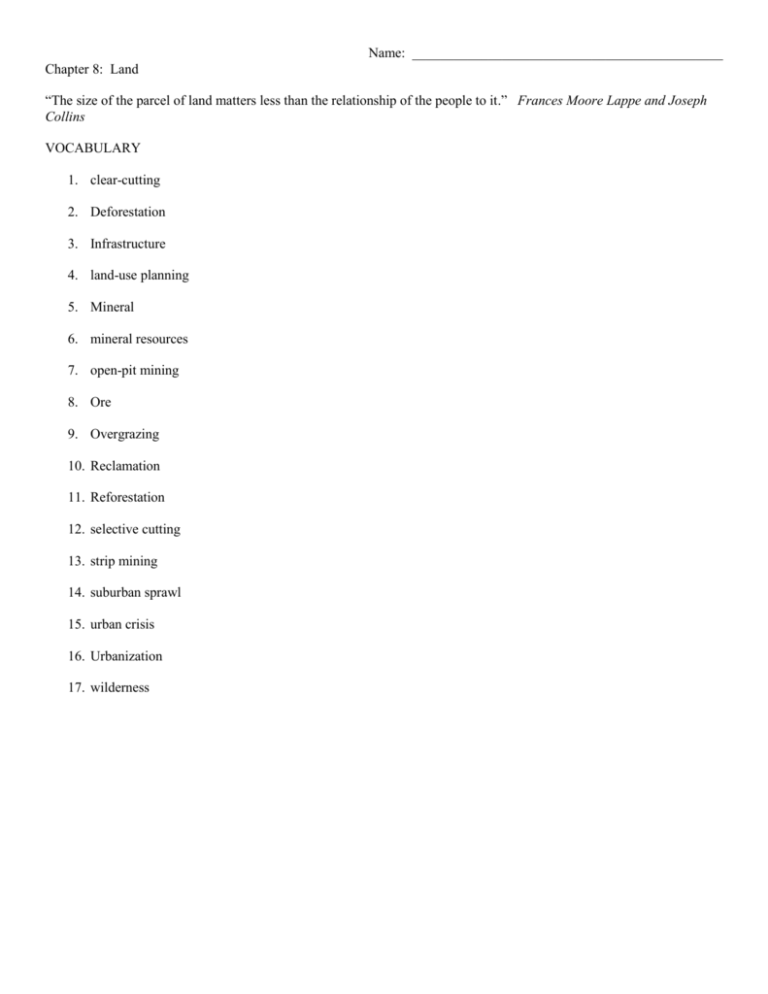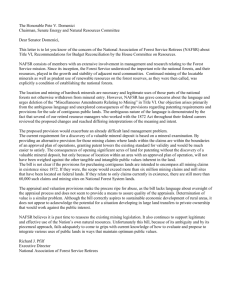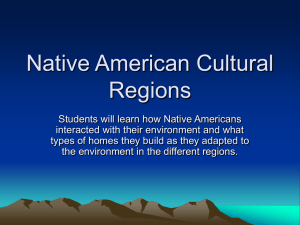Ch 8 Notes - complete
advertisement

Name: _____________________________________________ Chapter 8: Land “The size of the parcel of land matters less than the relationship of the people to it.” Frances Moore Lappe and Joseph Collins VOCABULARY 1. clear-cutting 2. Deforestation 3. Infrastructure 4. land-use planning 5. Mineral 6. mineral resources 7. open-pit mining 8. Ore 9. Overgrazing 10. Reclamation 11. Reforestation 12. selective cutting 13. strip mining 14. suburban sprawl 15. urban crisis 16. Urbanization 17. wilderness Ch. 8, Section 8.1: The City NOTES • In 1982, California used maps, aerial photos, field surveys and computerized mapping to see how much land was being used. • Over 8 years time, nearly 210,000 acres (84, 000 hectares) of productive farmland, rangeland and woodlands were converted into towns and cities. • Big concern: Prime agricultural land, forests and rangelands are being converted to cities. The Urban-Rural Connection • • • U.S. Census describes an urban area, or city, as a place with at least 5000 people per square mile About 2% of our country’s land is urban lands, 80% of Americans live in urban areas. By 2025, most likely 2/3 of the world’s population will live in cities Urban dwellers rely heavily on the resources of their surrounding environment – forests, croplands, rangelands Urbanization • • • • Until mid 1800’s, most people lived in villages and worked in surrounding land (farming); others managed forests, worked in mines, mills or manufacturing Today, farms are operated on less people, more machinery Transportation created less need to manufacturer to be located near customers; more people are moving to cities for employment Urbanization – growth of cities as people move from rural to urban areas; occurred rapidly between 1880 and 1950; today, occurring most rapidly in developing countries The Urban Crisis • • • Many cities have a difficult time keeping up with the number of people moving into the cities; faster than the number of jobs available and infrastructures available; thus increasing unemployment and increasing deterioration of living conditions Infrastructures are roads, sewers, railroads, bridges, canals, police and fire stations, schools, libraries, hospitals, water and power lines In developing countries, squatter settlements develop on the edge of overcrowded cities Suburban Sprawl • • Described as the development of housing and strip malls extending out around a city; offer more living space for less money, lower crime rates, more privacy Suburbs spread out over 2.5 million acres per year (1 million hectares); Los Angeles area has the largest and fastest growing area of suburban sprawl in the world Land-Use Planning • • • 1960’s (in Washington, D.C.) a commission established a plan to develop cities every 4 miles along a series of transportation corridors extending out from the city; like spokes on a wheel (called wedges-and-corridors) This plan allowed for wedges of non-urban, open spaces for recreation, agriculture and conservation of natural resources; allowed for growth and development for growing population; established itself as a leader in land-use planning (planning in advance for living space and natural space) Montgomery County had insight in planning for future growth; many other cities have been overwhelmed by rapid growth before they could develop a plan Mass Transportation • • • One of the biggest annoyances of a big city is the traffic; roads are clogged with cars, usually carrying only 1 person In 1993, it cost an individual in US about $1700/yr. in gasoline and maintenance; Europeans pay about ½ that amount using mass transportation (buses, subways, trains) Mass transportation is economical, energy-efficient, reduces highway congestion, air pollution and land loss Inner-City Renovation • • As people leave the cities, so do businesses; city areas fall into disrepair when they are not getting the money the businesses were providing Many cities are now receiving grants from the government, tax dollars and other assistance to induce private citizens to renovate areas (urban-renewal projects) Open Spaces • • • • The wedges in Montgomery County serve a valuable purpose: these open spaces alleviate many of the problems experienced in crowded cities (provide parks, pools, areas to bike, hiking trails, historical settings, gardens, agricultural areas) Benefits: give a place to escape crowded, noisy conditions in the city, civic activities, concerts, socialization Green space absorb carbon dioxide, produce oxygen, filter out pollutants, cool a city in summer months Areas with vegetation help reduce drainage problems (can absorb water runoff from rain and melting snow) Ch. 8, Section 8.2: How We Use Land NOTES • As populations grow, more land and resources are needed to support it; come from rural lands • Non-urban lands are being harvested: forests (for paper, furniture and home construction); grasslands (supporting livestock); mineral resources • These areas are becoming stressed by overuse Harvesting Trees • • • • Harvested trees are used for making paper, furniture, home building; we use an enormous amount of wood Worldwide: 1800 cu. Cm of wood per person each day; In US, we use 3.5 times this amount (equal to one 30 m tree/year) 1.5 billion people in developing countries depend on firewood for fuel Forest land is very valuable; In developing countries, many are being removed for farming or ranching; thought to improve quality of life Deforestation • • • • Forests are being cleared at an alarming rate and has become an environmental issue Defined as the removal of tress without replacing them; most prevalent in tropical rain forests (developing countries) Rain forests have poor soil; cannot support crops for only a short time; therefore, farmers need to continuously clear more forest areas Two types of clearing the land: Clear-cutting (removing all the trees from the land – damages animal habitats, increases soil erosion) & Selective cutting (removing only the middle aged or mature trees, the rest are left alone and are replaced by the seedlings – less damaging to the environment. Reforestation • • • • • The process of replacing trees that have died or been cut down; happens naturally from seeds that fall from nearby trees or humans replant seeds or seedlings When large numbers of trees are removed this cannot occur naturally because of the soil erosion and lack of shade for the delicate seedlings If successful, it can take 20 – 50 years or more to re-grow a forest Some governments require reforestation; 90% of all timber comes from forests not managed by governments; many are private owners Many states now require private landowners to reforest after timber is harvested Protecting Forests • • • Many governments are currently working to improve reforestation efforts and promote less destructive harvesting methods Private organizations have also established effective tree-planting programs; help to guarantee survival of forests Important to have these programs to help protect our forests and their resources Ranching • • • Rangelands support grasses and shrubs that are used by ranchers for grazing animals such as cattle, sheep and goats Essential for maintaining the world’s food supply Current population growth indicates a 40% increase in food production from rangeland between 1977 and 2030 Problems on the Range • • Grasses on the rangelands are highly adaptable and live through droughts, freezes, fires and animal grazing; the growing point of the grasses is at the base of every leaf; if the upper portion of the leaf is damaged, it will grow back; the root system consists of fibrous, dense mats; they hold the soil together to prevent erosion Overgrazing in an area will destroy the grasses beyond recovery; ranching in some parts of the world has contributed to the destruction of tropical forests Maintaining the Range • • • Public Rangelands Improvement Act (1978) has helped to improve the management of public ranges; includes two main components – grazing management and range improvement Grazing management – limiting animal herds to sizes the land can support; moving animals around to protect the plants Range improvement – eliminating sagebrush and other weedy plants that invade overgrazed land; replanting vegetation; digging water holes to keep livestock from overgrazing Mining • • • A surprising amount of land is used for mining minerals; used in cars, stereos, refrigerators, buildings, concrete, glass, brick and many other products we used everyday Minerals – solid substances found in nature and consist of a single element or compound (salt, gold, silver, iron, copper, aluminum) Two methods for extracting minerals: open-pit mining - machines dig large holes and remove ore; and stripmining - huge bull-dozers and other machines are used to clear away large strips of the Earth’s surface The Effects of Mining • • • Causes environmental damage; disruption of the land and ugly piles of waste materials left behind; habitats are lost; natural ecosystems are disrupted Large scale removal of vegetation can cause land erosion and landslides; toxic materials left behind can pollute both air and water; lots of energy is used extract and process the material US mines produce more waste than all the cities and towns combined; copper mines produce 1200 metric tons of waste per metric ton of copper metal produced Responsible Mining • • • One way to reduce the damage from mining is to restore the land to the condition it was before the mining began (reclamation) Environmental laws in the US now require companies to reclaim the mining sites on private land; some states have laws requiring reclamation on private land Another way to reduce the destructive effects of mining is to reduce the need for more minerals – by recycling Ch 8, Section 8.3: Public Land in the United States NOTES • In the early 1870’s, explorers expressed concern about the vast beauty of the west and asked the government to set aside that land for public use; birth of our national parks • The US government established 55 national parks and other protected lands to be used as public lands • US has encouraged other nations to do the same This Land Belongs to You and Me • • • 40% of all the land in the US is publicly owned Managed by federal, state and local governments Most of this government owned land is out west and Alaska; if you are a US citizen, you are a partial owner of these lands Managing Our Public Land • • • Because land resources are so valuable, this land can be used in several ways (multiple-use management); proving the greatest value for the greatest number of people Ex: National forest (recreation, logging, mining); private individuals and corporations can often harvest or extract natural resources Problem: different people have different ideas of how this land should be used; you will see battles between developers and conservationists Wilderness • • • Wilderness Act of 1964 defines wilderness as an area in which the land and the ecosystem it supports are protected from all development 657 regions covering 104 million acres have been designated as wilderness (open to hiking, fishing, boating – without a motor, camping); cannot build roads or use motorized equipment Provides habitats for wild animals and plants Troubled Lands • • As populations grow, people are using those wilderness areas and destroying them by trampling plants, eroding soil from trails and campsites, bathing, washing dishes (polluting rivers and streams), and leaving behind trash Originally, mining and ranching were allowed in wilderness areas (until 1983); filed petitions to remain in operation even to this day; nearby effects of grazing, logging, factories (air pollution) still affect these regions today “People Control” in Wilderness Areas • • • Limits have been established in some areas (how many people who can hike and camp); must apply for permits Some areas are off limits to camping and are patrolled Volunteers help to pick up trash and build trails; education programs are being implemented to help people better understand and reduce the impact on the natural world CASE STUDY Page 216 - PUBLIC LANDS FOR THE ASKING 1. Some people suggest that many new jobs could be created by reclaiming abandoned mines and restoring the landscape to it original state. They propose that such programs could be funded by mineral royalties. Do you think this is a good solution to the possible loss of jobs associated with reforming the mining laws? 2. Do you think the value of minerals in terms of jobs and resources outweighs the possible environmental damage that could result from mining activities? Why or why not?







